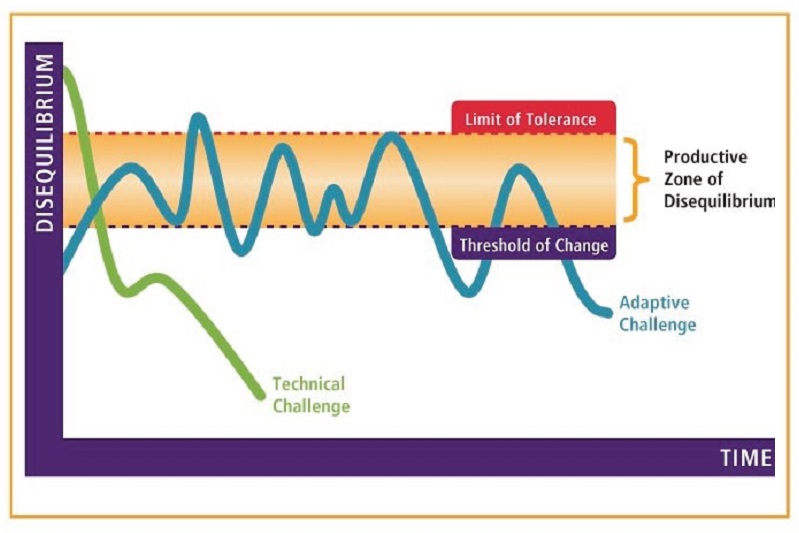We all know that change is never easy. Whether it’s accepting a new role or affecting systems-level improvements for better outcomes for children. Progress is built upon change, and change impels us out of our comfort zone. In our line of work, where we must venture into potentially uncomfortable areas in service of improving systems, we should look at a bit of heat as a good thing.
In adaptive leadership, the most productive space to work is referred to as the “Zone of Disequilibrium.” At Eastside Pathways, you won’t find Rod Serling in our Zone, but you will find one of our finely trained facilitators. Their very nuanced role is to help working groups arrive at, and stay in, this area where it’s not so cool that there are no potentially uncomfortable discussions, and where it’s not so hot that people disengage for their own well-being. One can’t help but think of Goldilocks’ quest for just the right porridge temperature.
Examine the image below that illustrates the “Productive Zone of Disequilibrium.” Below the Threshold of Change nothing major or long-lasting gets accomplished; the atmosphere is too relaxed to address thorny issues. The same lack of results occurs above the Limit of Tolerance, where it’s just too hot to be productive as emotions and discomfort eclipse purpose.

The Productive Zone of Disequilibrium is the sweet spot where change can happen.
In last month’s newsletter we discussed the difference between the easy-to-diagnose and fix Technical Challenge and the messier, longer-proposition Adaptive Challenge. You’ll note both ideas appear in the chart as well.
The technical begins with a lot of heat, usually because something vital to short-term goals is broken. It quickly drops through the productive zone and below the threshold of change as these easily fixed issues are addressed. Successful work on an adaptive challenge usually starts out in a much cooler environment as safe spaces are built, then stays within the productive zone, with occasional side trips to hotter and cooler climes. You’ll also note that adaptive challenges take a relatively longer time to address than technical challenges.
Creating, strengthening, and maintaining an environment where people can safely discuss values, perspectives, and ideas, is an important part of adaptive leadership, a core value and practice within Eastside Pathways Partnership.
Ronald Heifetz, co-developer of the Adaptive Leadership framework, gives the following definition of Productive Zone of Disequilibrium:
“The optimal range of distress within which the urgency in the system motivates people to engage in adaptive work. If the level is too low, people will be inclined to complacently maintain their current way of working, but if it is too high, people are likely to be overwhelmed and may start to panic or engage in severe forms of work avoidance.”
For another explanation, check out this informative, four minute video on the Productive Zone of Disequilibrium.
As we begin actively working on our Adaptive Challenges, understand that a little heat is a good thing. You can’t address an issue unless you acknowledge some of the discomforting issues surrounding it, but the end result is just right.
Goldilocks would agree.
